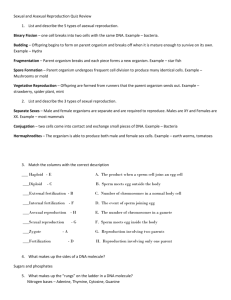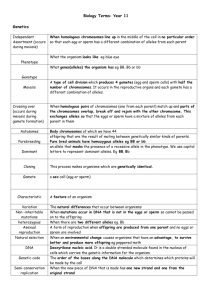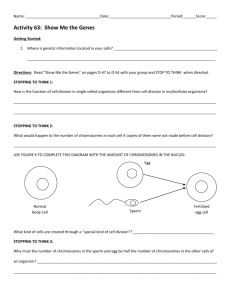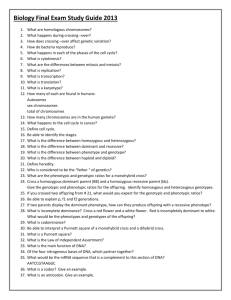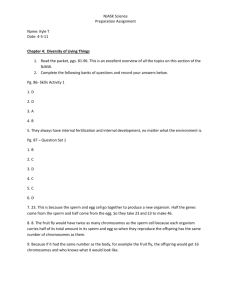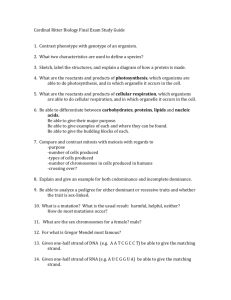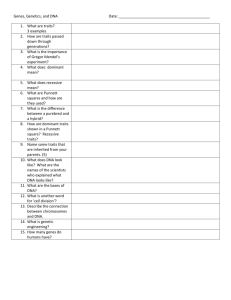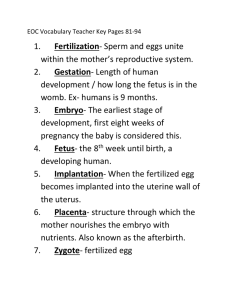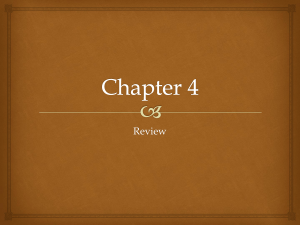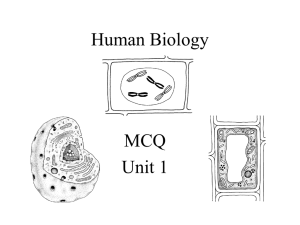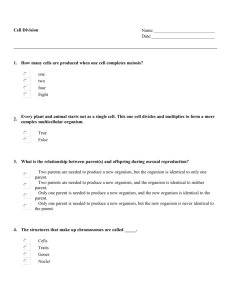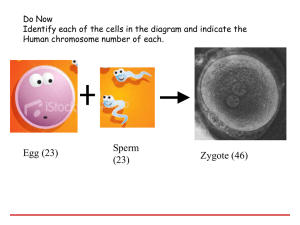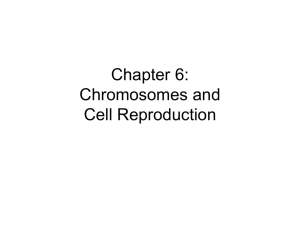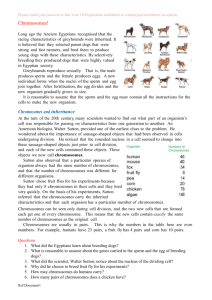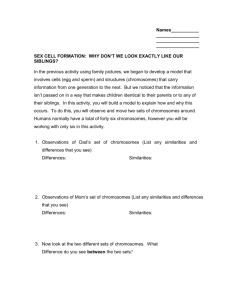Answers to Final Exam Study Guide Chapter 6 In Journal Double
advertisement
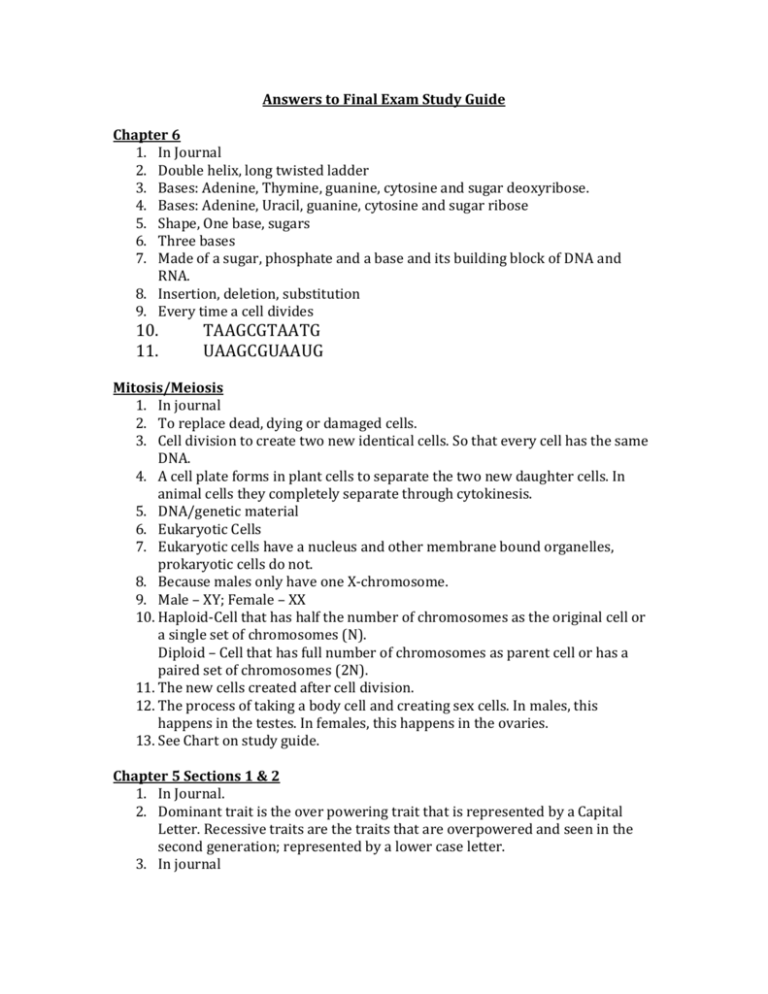
Answers to Final Exam Study Guide Chapter 6 1. In Journal 2. Double helix, long twisted ladder 3. Bases: Adenine, Thymine, guanine, cytosine and sugar deoxyribose. 4. Bases: Adenine, Uracil, guanine, cytosine and sugar ribose 5. Shape, One base, sugars 6. Three bases 7. Made of a sugar, phosphate and a base and its building block of DNA and RNA. 8. Insertion, deletion, substitution 9. Every time a cell divides 10. 11. TAAGCGTAATG UAAGCGUAAUG Mitosis/Meiosis 1. In journal 2. To replace dead, dying or damaged cells. 3. Cell division to create two new identical cells. So that every cell has the same DNA. 4. A cell plate forms in plant cells to separate the two new daughter cells. In animal cells they completely separate through cytokinesis. 5. DNA/genetic material 6. Eukaryotic Cells 7. Eukaryotic cells have a nucleus and other membrane bound organelles, prokaryotic cells do not. 8. Because males only have one X-chromosome. 9. Male – XY; Female – XX 10. Haploid-Cell that has half the number of chromosomes as the original cell or a single set of chromosomes (N). Diploid – Cell that has full number of chromosomes as parent cell or has a paired set of chromosomes (2N). 11. The new cells created after cell division. 12. The process of taking a body cell and creating sex cells. In males, this happens in the testes. In females, this happens in the ovaries. 13. See Chart on study guide. Chapter 5 Sections 1 & 2 1. In Journal. 2. Dominant trait is the over powering trait that is represented by a Capital Letter. Recessive traits are the traits that are overpowered and seen in the second generation; represented by a lower case letter. 3. In journal 4. Alleles are one of the alternative forms of a gene that governs a characteristic. They are usually represented by a letter. 5. Phenotype – the physical appearance of an organism based on its genetic make-up. Genotype – the combination of alleles for one or more specific traits. 6. On paper. 7. Genotypes: 2 – Bb; 2 – bb Phenotypes: 2 – Brown eyes; 2 – Blue eyes 8. Homozygous: two dominant (BB) or two recessive (bb) alleles. Also known as purebred. Heterozygous: One dominant and one recessive allele paired together (Bb). 9. A. Heterozygous B. Homozygous C. Homozygous D. Heterozygous Chapter 9 1. Study Foldable and vocabulary from journal. 2. Kingdom, Phylum, Class, Order, Family, Genus, Species 3. A series of paired statements to help identify an unknown organism. 4. Genus and Species 5. Characteristics 6. Plant and Animals Chapter 3 – Not on Test 1. In journal 2. All cells come from existing cells, cells are the basic unit of life, all living things are made up of one or more cells. 3. Not going to be on test. Reproductive System 1. In journal 2. Budding – Hydra Regeneration – Sea Star Fragmentation – Flat worms 3. The union of an egg and sperm. 4. A zygote is the name for a fertilized egg. 5. The process of egg and sperm formation. 6. Where genetic information is found on chromosomes. 7. A string of DNA that gives instructions for characteristics and function in an organism. Humans have 46. 8. Internal fertilization occurs inside the female’s body and external fertilization occurs outside the female’s body in a moist environment. 9. Monotreme – mammals that lay eggs. Platypus or echidna Marsupial – mammals that give birth to partially developed offspring and then they move into the pouch to continue development. Kangaroo or Opossums. Placental mammals – babies develop inside the mother’s body the whole length of pregnancy. Dogs, cats, humans 10. Did not have to do. 11. The release of an egg from the ovaries. 12. Fertilization is the union of egg and sperm. Implantation is when the zygote embeds itself in the wall of the uterus. 13. Usually in the fallopian tubes. 14. To prepare the female’s body for pregnancy. About the 14th day of the cycle. 15. Identical twins come from one egg, fertilized by one sperm. Have the same DNA. Fraternal twins are separate eggs that are fertilized by separate sperm. They do not have the same DNA. 16. Diseases transmitted by sexual contact. HPV, HIV, herpes, Hepatitis B. 17. Testes and prostate in men. Breast and Cervical in women. 18. Unable to have children. STD’s, 19. It is the organ where the baby is fed and develops in the mother. 20. 11 to 12 days after fertilization. 21. Muscular contractions that help deliver the baby. 22. Do not need to know. Circulatory/Cardiovascular System 1. In journal 2. Plasma, red blood cells, platelets, white blood cells 3. Carries oxygen and nutrients to all parts of your body. 4. An oxygen carrying protein found in blood. 5. Atria – upper; Ventricles - lower 6. In the lungs through the alveoli. 7. Cardiac 8. Arteries – take blood away from the heart. They are thick. Veins – carry blood to the heart from the body. Have valves to help with movement against gravity. 9. They are the tiniest and thinnest blood vessels where exchange of materials occur between the blood stream and the cell/tissue of the body. 10. Body - Right Atrium – Right Ventricle – Pulmonary artery – lungs – Pulmonary vein – Left atrium – Left Ventricle – Aorta – To the body Chapter 22 1. In journal 2. All bodily functions have to have a stable internal environment to keep the body functioning properly. 3. Cell – tissue – organ – organ system – organism 4. Connective, Nervous, Epithelial and muscle tissues 5. 206 6. Protection, Storage, Movement, Blood Cell Formation. 7. Compact – rigid and dense, outer part of the bone. Spongy – has many open spaces, but provides the most strength and support for a bone. 8. Cartilage is a flexible tissue that provides cushion between joints and is located in your nose and ears. 9. Soft tissue in bones, red and white. Produces blood cells. 10. Gliding Joint – allows bones to glide over each other – wrist and hand Ball-and-Socket Joint – a joint that allows movement in all directions. Like your shoulder or hip. Hinge Joint – Joint that allows you to flex and extend a body part. An elbow or knee. 11. A joint that does not move – Skull 12. Ligaments 13. Sprain – when a ligament is stretched to far or torn. Osteoporosis – A disease that causes bones to become less dense, which cause them to break easily. Arthritis – swelling of the joints. 14. Skeletal – Quads, biceps, hamstrings Smooth – moves food through your digestive system Cardiac – found in the heart 15. Involuntary muscles are not controlled by you – heart, diaphragm. Voluntary muscles are controlled by you – skeletal muscles 16. Tendons 17. Pairs 18. Flexor – bends ex: biceps; Extensor – straightens ex: triceps 19. One muscle in the pair bends and the other straightens. 20. Resistance exercise – strengthen muscles; Aerobic exercise – strengthens the heart and increases endurance 21. Strain – When a muscle or tendon is overstretched or torn; Tendonitis – When a tendon becomes inflamed or swollen. Chapter 18 1. Abiotic – not living (rocks, sun, air, clouds, sand) Biotic – Living (birds, bacteria, plants, humans, snakes) 2. In journal 3. Consumers have to eat other organisms for survival. Ex: humans, birds, dogs, snakes, cats. 4. Producers are able to make their own food internally by using the sun as energy. Ex: trees, grass, plants. 5. Grass – grass hopper – red bird 6. The flow of energy from one organism to another. Shows what organism is doing the eating.


